✪ Key Takeaway: Salt can help raise blood pressure temporarily but works best when combined with proper hydration and medical supervision.
Introduction
Your doctor just told you to eat more salt, and you are confused because everyone else says salt is bad for health.
You might be asking this question because you experience dizziness, fatigue, or fainting spells that could be related to low blood pressure, and you want to know if adding salt to your diet will actually help these uncomfortable symptoms.
Hi, I am Abdur, your nutrition coach, and today I am going to explain exactly how salt affects low blood pressure symptoms and when it actually works as a treatment option.
How Does Salt Actually Raise Blood Pressure?
Salt works by increasing the volume of fluid in your blood vessels, which creates more pressure against the vessel walls.
When you consume sodium, your kidneys retain more water to maintain balance between sodium and fluid levels in your body.
This extra water increases your total blood volume, similar to adding more water to a garden hose that is already flowing.
Your heart then pumps this increased volume of blood through the same network of blood vessels, creating higher pressure throughout your circulatory system.
The effect typically begins within 30 minutes of consuming salt and can last for several hours, depending on your individual kidney function and overall health status.
✪ Fact: Your kidneys can process about 400mg of sodium per hour under normal conditions.
When Does Salt Help With Low Blood Pressure Symptoms?
Salt helps most effectively when your low blood pressure is caused by dehydration or low blood volume, conditions known as hypovolemic hypotension.
People who experience orthostatic hypotension, where blood pressure drops when standing up, often benefit from increased salt intake combined with adequate fluid consumption.
Athletes and people who sweat excessively may develop low blood pressure symptoms because they lose both sodium and water through perspiration.
Elderly individuals often have reduced kidney function and may need slightly more sodium to maintain adequate blood pressure levels for proper organ function.
However, salt will not help if your low blood pressure is caused by heart problems, medication side effects, or endocrine disorders that require specific medical treatment.
The key is identifying whether your symptoms stem from volume depletion or other underlying medical conditions that need different approaches.
✪ Pro Tip: Track your symptoms and salt intake for one week to identify patterns before making dietary changes.
What Are The Risks Of Using Salt For Low Blood Pressure?
Excessive salt intake can cause fluid retention that leads to swelling in your legs, ankles, and hands.
People with kidney disease may not be able to process extra sodium properly, leading to dangerous electrolyte imbalances that affect heart rhythm.
Some individuals may experience a rebound effect where their blood pressure swings too high after consuming large amounts of salt, creating cardiovascular stress.
Long-term high sodium intake can damage blood vessel walls and increase the risk of stroke and heart disease, even in people with naturally low blood pressure.
The balance between helping low blood pressure and avoiding these complications requires careful monitoring and often medical supervision.
✪ Note: Never exceed 2300mg of sodium daily without medical supervision, even for low blood pressure treatment.
How Much Salt Should You Use For Low Blood Pressure?
Most doctors recommend starting with 1500-2000mg of sodium per day for people with symptomatic low blood pressure.
This amount equals roughly three-quarters of a teaspoon of table salt spread throughout your meals and snacks during the day.
You should increase salt intake gradually over several days while monitoring your blood pressure response and symptom improvement.
Combining salt with adequate water intake is crucial because sodium without sufficient fluid can actually worsen dehydration and symptoms.
The timing matters too – consuming small amounts of salt with each meal works better than taking large amounts all at once.
Natural sources like sea salt, celery, and olives provide sodium along with other minerals that support healthy blood pressure regulation.
✪ Pro Tip: Drink 8-10 glasses of water daily when increasing salt intake to maximize the blood pressure benefits.
The Bottom Line
Salt can effectively help manage low blood pressure symptoms when used correctly and under appropriate circumstances.
The best medicine is often the simplest one, but only when you understand how and when to use it properly.
I would love to hear about your experience with managing low blood pressure symptoms or any questions you might have about using salt safely – please share your thoughts in the comments below.
References
At NutritionCrown, we use quality and credible sources to ensure our content is accurate and trustworthy. Below are the sources referenced in creating this article:
- Hackensack Meridian Health: Can Salt Help Improve Low Blood Pressure
- Harvard Health: Dietary Salt and Blood Pressure: A Complex Connection
- Mayo Clinic: Hyponatremia Low Sodium Level Blood
- National Kidney Foundation: Hyponatremia Low Sodium Level Blood





